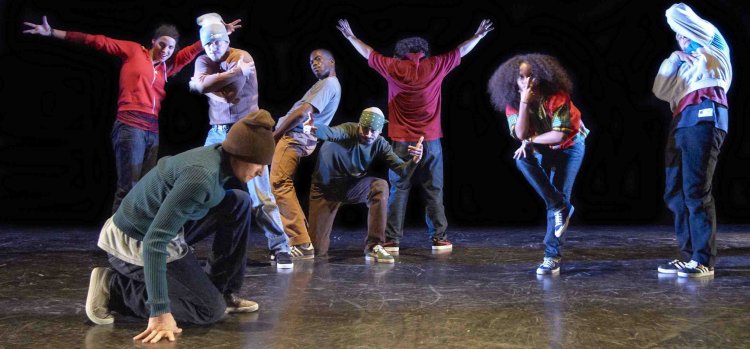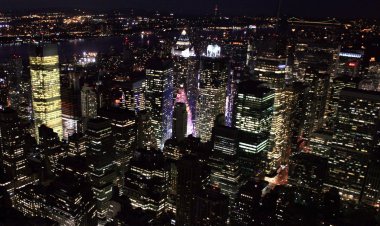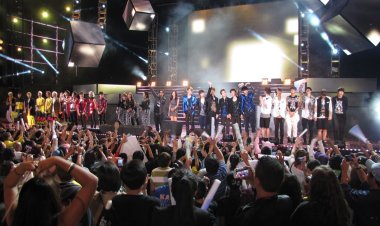Pop & Lock Dance Moves and Global Grooves

5 Iconic Popping Dance Moves to Learn
Some of the most iconic Popping moves are fairly simple to pick up and fun to do. Once you've got the basics down, you can start stringing different moves together into your own funky combos.

1. The Hit
A sharp, sudden movement, like being struck. Pull your arm across your body and thrust it out straight, tensing your muscles. Repeat with the other arm. This works great on the dance floor when the beat drops!
2. The Wave
You've definitely seen this smooth, rippling move before. Start with your hand, wrist, and forearm, quickly tensing and releasing to create a wave-like effect that travels up your arm. Practice the timing and increase your speed. For extra style points, do The Wave with both arms at once.
3. The Pop
The signature Popping move. Bend one knee and tense your muscles to create a jerky "popping" effect. Release and repeat, alternating knees. Once you've got it with your legs, practice popping your chest, shoulders and glutes. Combine pops for a robotic effect.
4. The Dime Stop
Move smoothly across the floor, then stop suddenly in your tracks, freezing in place. Remain completely still, as if someone pressed pause on a remote. After a few seconds, unfreeze and continue dancing. This unexpected move is sure to impress! Practice your timing and muscle control.
5. The Lock
Similar to The Dime Stop, move dynamically and then abruptly lock your body into a stationary position, holding the pose with flexed muscles. Release sharply to keep dancing. Locking both creates visual contrast in your routine and shows off body control and strength. With practice, you'll be popping and locking in no time!
3 Fundamental Locking Techniques
To get started with locking, you'll want to learn a few fundamental techniques. Mastering these moves will allow you to start creating your own unique sequences and styles.
The Wave
The wave is a smooth, flowing arm movement. Start with your arms at your sides. Raise one arm up and over in a circular motion, keeping your hand open. As that arm comes down, raise your other arm and repeat. Coordinate this motion to create a wave-like effect with your arms. Practice the speed and range of motion with this foundational move.
Points
Points are quick, abrupt movements done with your fingers, hands, and arms. Extend your arm and point your index finger, quickly drawing it back. You can point up, down, diagonally or straight ahead. Do single points or string several together for a staccato effect. Points are a staple of locking and you'll use them frequently in your routines.
Pops
Pops are fast, jerky movements where you thrust a limb out and quickly retract it back in. To do a pop, extend your arm out straight, pull it back in fast while keeping your arm straight. Pops are bold, visual moves that are meant to be dramatic and rhythmic. They add emphasis and punctuation to your sequences. Practice doing single pops, then string a few together for maximum effect.
With practice, these three techniques - the wave, points and pops - will become second nature. You'll soon be combining them in creative ways, adding in footwork and developing your own signature style. Keep at it and enjoy discovering what your body can do - the possibilities are endless!
Influences From Afrobeat, House, and Hip Hop
The energetic and free-flowing pop and lock dance moves have been influenced by several genres over the years. Three of the biggest influences are Afrobeat, house music, and hip-hop.
Afrobeat
Afrobeat, which originated in West Africa, is known for its heavy percussion, horns, and political lyrics. The rhythmic beats and pulsing rhythms have inspired many pop and lock moves, especially footwork that incorporates fast leg movements, stomps, and kicks. Dancers often move their whole body to the driving beats, rotating their hips and shoulders.
House Music
House music, which started in Chicago in the 1980s, emphasizes electronic synthesizers and a repetitive four-on-the-floor beat. This pulsating sound has inspired pop and lock moves like the running man, the butterfly, and liquid dancing with smooth waves and ripples of the body. The upbeat tempos of 120 to 130 beats per minute keep dancers moving continuously.
Hip Hop
Hip-hop music and culture have been instrumental in the development of pop and lock dance. Breakdancing moves from hip hop like the top rock, down rock, freezes, and power moves have influenced pop and lock styles. The energetic and rhythmic music also inspired dancers to get creative with their moves. Locking, which involves quick muscle contractions and ‘locking’ of the joints, developed out of hip hop along with other street dances in the 1970s.
These musical genres have blended together over time, combining heavy beats, electronic sounds, and urban attitude. The fusion has allowed pop and lock dance to become a vibrant and diverse form of creative expression. Dancers all over the world now put their own cultural spin on the moves, leading to endless variations and global grooves.

 Admin
Admin 










